 
Explorations: Introduction to Astronomy (Arny), 6th EditionChapter 12:
The Sun, Our Star  <a onClick="window.open('/olcweb/cgi/pluginpop.cgi?it=jpg::::/sites/dl/free/0010202009/220722/chapter12.jpg','popWin', 'width=NaN,height=NaN,resizable,scrollbars');" href="#"><img valign="absmiddle" height="16" width="16" border="0" src="/olcweb/styles/shared/linkicons/image.gif"> (108.0K)</a> <a onClick="window.open('/olcweb/cgi/pluginpop.cgi?it=jpg::::/sites/dl/free/0010202009/220722/chapter12.jpg','popWin', 'width=NaN,height=NaN,resizable,scrollbars');" href="#"><img valign="absmiddle" height="16" width="16" border="0" src="/olcweb/styles/shared/linkicons/image.gif"> (108.0K)</a> | |
- Astronomers can learn much about stars, such as their temperature and composition, from the spectra of their light.
- Many stars are members of binary star systems in which one star orbits another.
- Study of binary star motions gives information about the stars’ mass.
- Classification of stars by their temperature and intrinsic brightness shows that stars can be divided into three main groups:
- Main-sequence stars.
- Red giants.
- White dwarfs.
- Main-sequence stars obey the mass–luminosity law:
- More-massive stars are more luminous.
- Some stars pulsate, so that their size and brightness change.
|
 |  |
|





